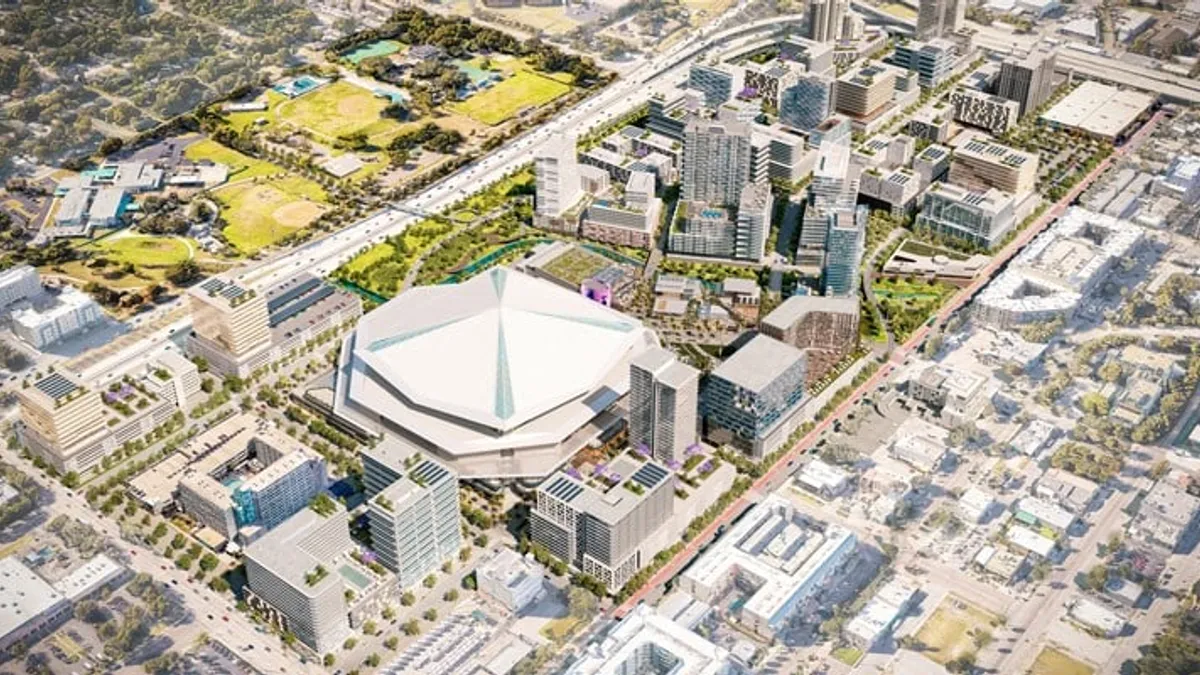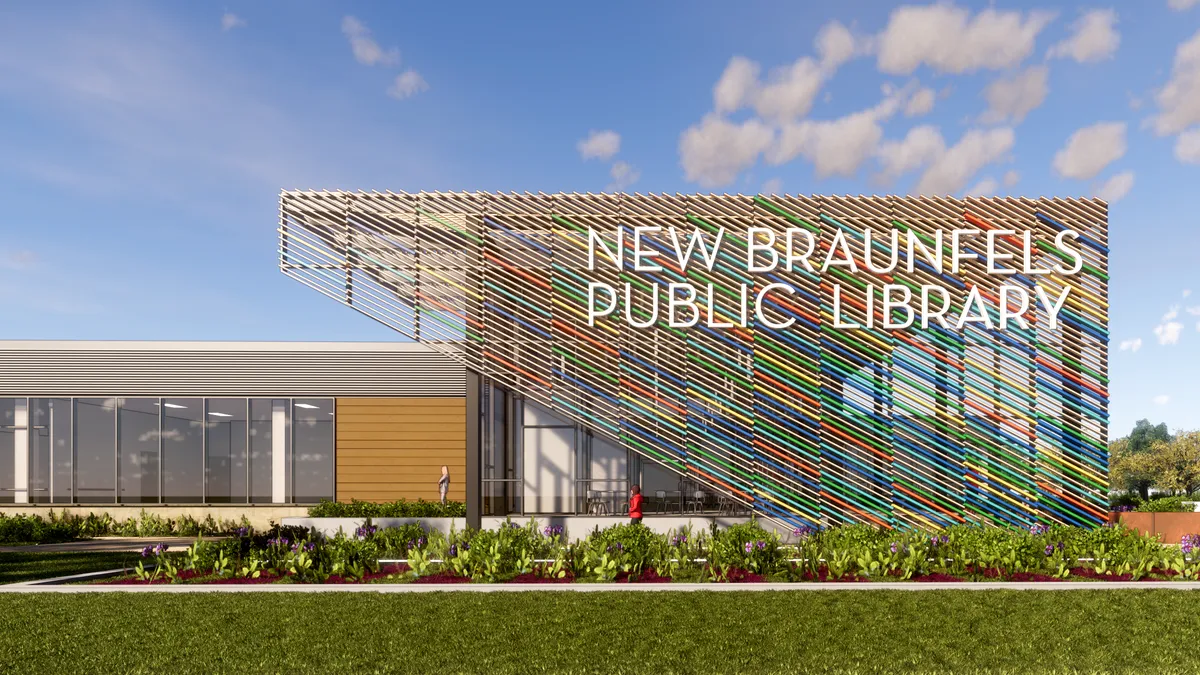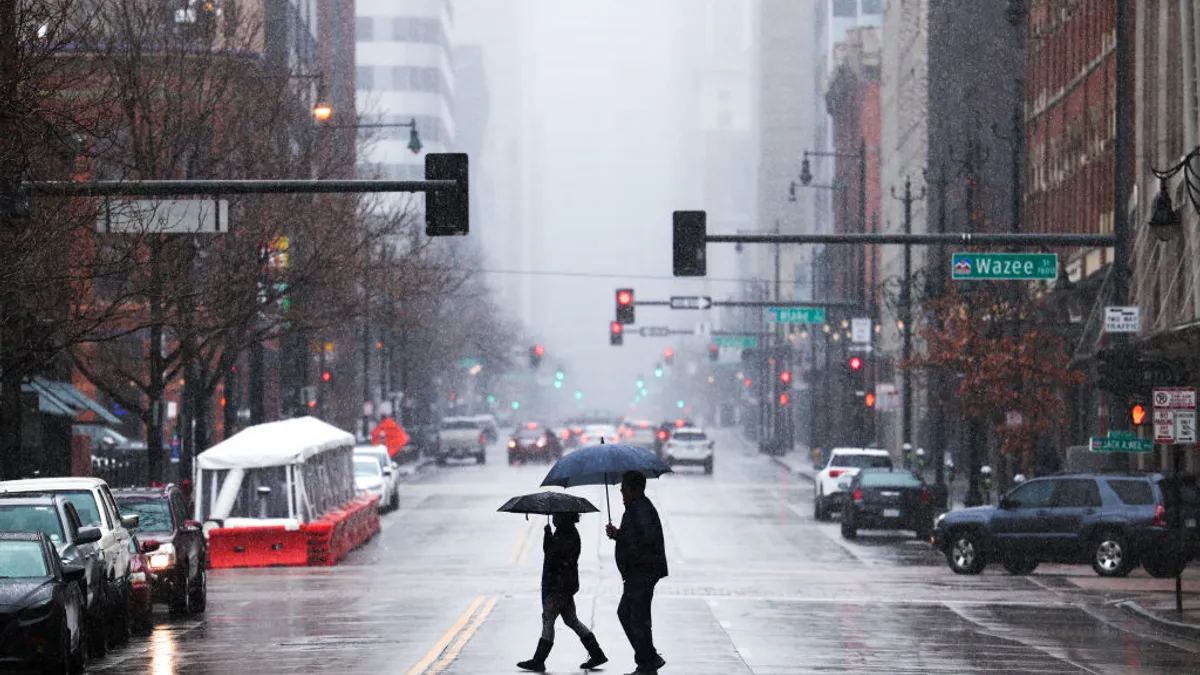From national sporting events to sell-out pop tours, venues are of the few places that can still bring together thousands of people for one singular event.
The likes of AT&T, Johnson Controls, Nokia and IBM are rolling out internet of things (IoT) technology to drive efficiencies at city stadiums and venues for employees who work there and those who attend their myriad events. While doing that, they are exploring how smart venues can act as testbeds for smart city policy, all while making these cathedrals of sports, music and other events accessible for as many people as possible.
"Every team is looking to make the fan experience more engaging, to engage them deeper into that brand whatever that may be, whether it be soccer, or football, or NASCAR," Michael Zeto, general manager and executive director of AT&T Smart Cities and VP of IoT, told Smart Cities Dive in an interview.
Enhancing the fan experience
When it comes to fan engagement and the inefficiencies IoT technology could potentially solve, David Hagan, CEO of Boingo Wireless, spoke of some possibilities during a January panel at CES in Las Vegas. He reflected on going to an NFL game around Christmas, but that everything about the day was “hard.”
"[Getting] to the stadium was a royal pain, parking was a royal pain, getting through security with a physical paper ticket was a pain, ordering concessions was a pain — you miss half a quarter to go stand in line — getting out of the stadium at the end was a pain,” he said. “Sitting at home with an 85-inch ultra HD TV is really easy. And so, to me the smart venue has to take all those things in the fan experience that are difficult, and it just needs to become easy.”
Hagan said many innovations using IoT could help ease hardships, including more people riding in autonomous vehicles (AVs) to ease traffic congestion and the use of augmented reality (AR) and virtual reality (VR) to bring people closer to the action.
Zeto said 5G is also going to be a game-changer, as people will "have the ability to take AR and VR and overlay that on top of an application experience that they’re already engaged in and really see and feel what’s happening with that player on the field."
As part of its smart venues strategy, AT&T has gone into stadiums around the country and provided them with cutting-edge technology. At AT&T Stadium in Arlington, TX, the company has provided high-speed internet connectivity and a digital interactive experience for fans through kiosk solutions and signage. Those digital offerings include information on restrooms and concession locations, as well as advertising for sponsors.
In future projects, Zeto said AT&T is looking to make new stadium buildings smart from the get-go, while also looking to install their technology in stadiums being renovated or expanded.
And that technology does not need to be integrated into construction projects to be useful. It instead can be offered to venue owners who are looking for quick solutions to today’s problems. The tiered approach is similar to the dilemma around smart buildings in general, as owners decide whether to retrofit, renovate or redevelop from the ground up.
It is not just AT&T putting in the hard yards to make venues smarter. Nokia released a video dubbed “From Smart Venues with Love,” which lays out a comprehensive look at a smart venue experience including parking and concession efficiencies, high speed Wi-Fi, and more.
Last year, Nokia successfully tested its Wi-Fi and cellular connectivity applications in Notre Dame Stadium, using technology that could potentially give the more than 80,000 fans that attend Notre Dame football games in South Bend, IN better data connections and preventing wireless towers from getting overloaded. The technology is known as Mobile Edge Computing, and enhanced mobile access to video streams and AR to improve the fan experience
“By deploying applications at the network edge, rich, engaging content is brought closer to consumers, application response times are reduced while reliability is increased — all of these benefits offer a truly excellent user experience,” Joe Hammer, Global Alliance director for Nokia, said in a statement at the time.
Meanwhile, IBM worked to help create Mercedes-Benz Stadium in Atlanta and implemented what it called “architecture infused with IT to deliver ultimate fan experience” according to the tech company’s website. Stadium developers tout queue line design that minimizes wait times for concessions and the largest video screen in professional sports, called the Halo Board. And the stadium’s retractable roof was finished in July.
The business side: Strategy and public-private partnerships
From a business standpoint, a better fan experience at a stadium means they are more likely to spend money and return for future events. But for the stadiums themselves, getting smarter and more innovative means engaging in public-private partnerships (P3s) while also making sure new efficiencies benefit as many people as possible, including stadium employees themselves.
One company looking to make sure their smart venue benefits not only visitors but also employees on site is Johnson Controls, which is leading the way on the Johnson Controls Hall of Fame Village in Canton, OH, next door to the Pro Football Hall of Fame. Described as a “once-in-a-lifetime project,” the Village is home to a 23,000-seat stadium and is planned to host various hall of fame exhibits, a hotel and a conference center.
Clay Nesler, Johnson Controls’ vice president of global sustainability and industry initiatives for the Building Technologies and Solutions business, said the Hall of Fame Village will support the entire community and its associated infrastructure.
“We’re creating a community that will not only benefit the fans, but also the operations teams by connecting different technology systems with the broadband communications throughout the entire city,” Nesler told Smart Cities Dive in an email. “It’s fun to think about the technology we’re integrating and the eventual outcomes, and also the systems that we haven’t even thought of yet, but will be able to support in the future.”
And there also is a trend toward more connectivity between venues and their host cities, a far cry from the so-called “cookie-cutter stadiums” of the mid-20th century that were built on masses of land with enormous surface parking lots and few other connections to the community.
“It’s fun to think about the technology we’re integrating and the eventual outcomes, and also the systems that we haven’t even thought of yet, but will be able to support in the future.”

Clay Nesler
Vice president of global sustainability and industry initiatives for the Building Technologies and Solutions business, Johnson Controls
Now, stadiums are expected to be a bigger part of the city, with transit options just one component of their overall integration into infrastructure. Earlier this year, Minneapolis continued that trend when it promised the “most transit-reliant Super Bowl ever played,” which emphasized the need to fully utilize the city’s light rail system to avoid crippling traffic congestion.
Hosting such large events then helps the city’s economy, Zeto said.
“If you don’t have an efficient transportation system that is accessible by everybody from everywhere you cannot effectively bid on those large events and win,” he said. “And if you win one of those events, and you get into that process of continuously winning different types of large sporting events that come to town every couple years, you’re talking about hundreds of millions of dollars of economic impact, in some cases every time one of those comes to your city.”
But any discussions of economic impact must not neglect the continuing debate over public money funding new stadiums, however smart they may be. The United States was part of a winning bid with Canada and Mexico for soccer’s 2026 World Cup, but the bid came in for criticism from some cities who did not want to put public money towards hosting games.
Three U.S. cities — Chicago, Minneapolis and Glendale, AZ — withdrew from consideration over what they felt were unknown costs associated with hosting such a tournament, including stadium investments as well as security. Vancouver raised similar concerns over what British Columbia (BC) tourism minister Lisa Beare told reporters were the "unknown costs and unknown risks to BC taxpayers."
How smart venues can incubate smart city initiatives
With all this innovation coming to venues, industry experts say some of those innovations can be scaled up to make cities smarter in general.
Nokia wasted little time in using initiatives similar to smart venue improvements to add value for cities. In late July, Nokia partnered with Current to bring City IQ to Canadian cities. The partnership will enable app developments to tackle parking, traffic, and public safety. The work of corporations including AT&T and Nokia highlight the growing parallels between smart stadiums and smart cities.
“‘Smart cities’ is a phrase that everyone uses, but it can mean many different things,” Nesler added. “Our research shows that many of the same desired outcomes we talk about around smart buildings — sustainability, public safety, communications — apply not only to high performance facilities like Fenway Park, but to cities at large.
Zeto said such innovations, including around areas like efficient energy usage, crowd control or water quality that may use IoT technology, can be more widely used if cities work with those in the private sector to make their ideas more widely available.
That is already the case in startup initiatives such as the Startup in Residence program, or at startup accelerators like URBAN-X in Brooklyn, NY, where the government and private sector are brought together to find innovative solutions to urban problems.
“It gives you an opportunity from an economic development perspective to get local entrepreneurs, developers, and the tech ecosystem engaged in innovation centers that could potentially even be placed in a stadium because of the amount of real estate that’s there or in that entertainment or business district that’s being developed around it,” Zeto said.
But, Nesler warned, the emphasis on smart venues being a testbed for smart city innovations must be tempered with a need to ensure everything is safe. That warning comes just months after cities like Atlanta and Baltimore have struggled with cyberattacks and their aftermath.
“On the precautionary side, our research suggests that cybersecurity is an increasingly important issue and one that should be considered up front when making building system and technology investments,” Nesler said. “Careful investment in technology platforms and their integration can allow venues, buildings and cities to become Smart Ready and keep pace with advancing technology for years to come.”



















